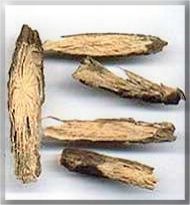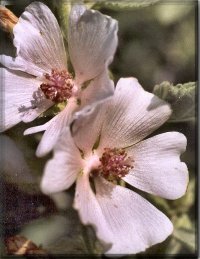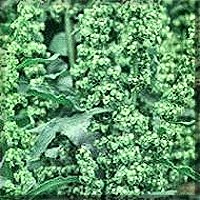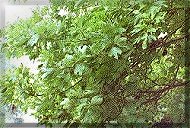
This root beer recipe was found among several published pre-Prohibition root beer recipes! Fermentation has been used by mankind for thousands of years for raising bread, fermenting wine and brewing beer. The products of the fermentation of sugar by yeast are ethyl alcohol and carbon dioxide. Carbon dioxide causes bread to rise and gives effervescent drinks their bubbles. This action of yeast on sugar is used to 'carbonate' beverages, as in the addition of bubbles to champagne).
The main fermentable in this recipe is molasses! This beverage contains about 2 to 3% alcohol (malted barley and fermentation is involved) but still considered a legal non - alcoholic beverage. All of the roots used have been historically attributed with healing properties and are generally available at, or may be ordered through, your health food store.
Ingredients to make 2 gallons of extract (wort-equivalent):
Measure by dry weight, each, of the following dried and cut roots.

a.k.a. Bardana, Beggar's Buttons, Burdock, Burr, Burr Seed, Clot-burr, Clothburr, Cockleburr, Dock, Fox's Clote, Grass Burdock, Hardock, Hareburr, Horseburr, Hurrburr, Klettenwurzel (Ger), Lappa, Lopuh (Russ), Love Leaves, Pricker Plant, Repeinik (Russ), Stick Button, Thorny Burr, Turkey Burrseed)!
Extracts have shown the following effects: antibacterial, antifungal, antifurunculous, antitumor (1964), diuretic, estrogenic, hypoglycemic, also said to contain antiviral compounds! NOTE: Extracts of the root are phototoxic to Candida albicans and Saccharomyces cerevisiae.

Dandelion leaves are a powerful diuretic. The roots act as a blood purifier that helps both the kidneys and the liver to remove toxins and poisons from the blood. The roots have been used for centuries to treat jaundice. Dandelion also acts as a mild laxative and improves appetite and digestion. It is useful for eczema-like skin problems, boils, and abscesses, and is believed to help prevent age spots and breast cancer.


One of the most widely used herb from the ancient medical history of Ayurveda, both as a medicine and also as a flavoring herb to disguise the unpleasant flavor of other medications. It is a very sweet, moist, soothing herb that detoxifies and protects the liver and is also a powerful anti-inflammatory, being used in conditions as varied as arthritis and mouth ulcers. Licorice is one of the most commonly used herbs in Western herbal medicine.

Traditionally, Marshmallow root has been poulticed on bruises, muscle aches, sprains, burns, and inflammations. A tea of the leaves has been used to soothe sore throat and as an expectorant in bronchitis and whooping cough. Like many members of the mallow family, its tea is considered soothing to an upset stomach. Both the fresh and dried leaves have been used for similar conditions as the root but are considered somewhat weaker.

The rhizome used by North American Indians both for medicine and as food. Wine was made from the berries by European settlers and a form of root beer was made from the rhizome. In the 1800's, sarsaparilla was popular as a spring tonic

The botanical name has its roots in the Hindu word Jatamansi which means "lock of hair." It's use goes back in several cultures and religions. Medically it's part of the Ayurveda, and is traditionally considered to calm the nerves and promote awareness and strengthen the mind. It is in the same family as Valeriana jatamansi (Indian valerian) and was sometimes used treatment of hysteria.

The Yellow Dock is applicable to all the purposes for which the other species are used. The root has laxative, alterative and mildly tonic action, and can be freely used as a tonic and laxative in rheumatism, bilious complaints and as an astringent in piles, bleedings of the lungs, etc. It is largely prescribed for diseases of the blood, from a spring eruption, to scurvy, scrofula and chronic skin diseases. It is also useful in jaundice and as a tonic to the stomach and the system generally. It has an action on the bowels very similar to that of Rhubarb, being perhaps a little less active, but operating without pain or uneasiness.

There are over 150 varieties of vanilla orchids (there are 27 varieties in South Florida alone), but only two species are used commercially to flavor and fragrance foods and beverages-- Bourbon and Tahitian. Bourbon beans are botanically known as Vanilla planifolia or Vanilla fragrans and originally came from the Gulf Coast of Mexico

The roots, bark, and leaves of the sassafras have a spicy scent and the oils extracted from them have been used in soapmaking and in flavoring drinks, such as sassafras tea. Four different leaf shapes can be found on one sassafras tree: three lobed, elliptical, two lobed/right side, and two lobed/left side (upper photo). The deciduous leaves can grow up to six inches by four inches, and the tree itself may grow up to about 30 feet on Assateague, and even up to 60 feet elsewhere. In the spring, small yellowish green flowers develop with the leaves; oval-shaped, blue fruits of less than half an inch follow.
Other Ingredients:
Method for the wort-equivalent:
Finishing:
Bottling:
Charge each cleaned and sanitized 12 oz. bottle with one-eighth tsp dry cane sugar after having finished siphoning into the bottles and before capping them.